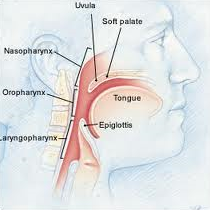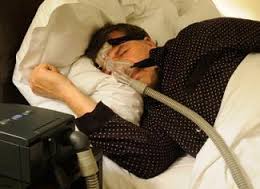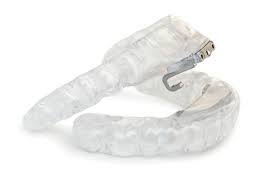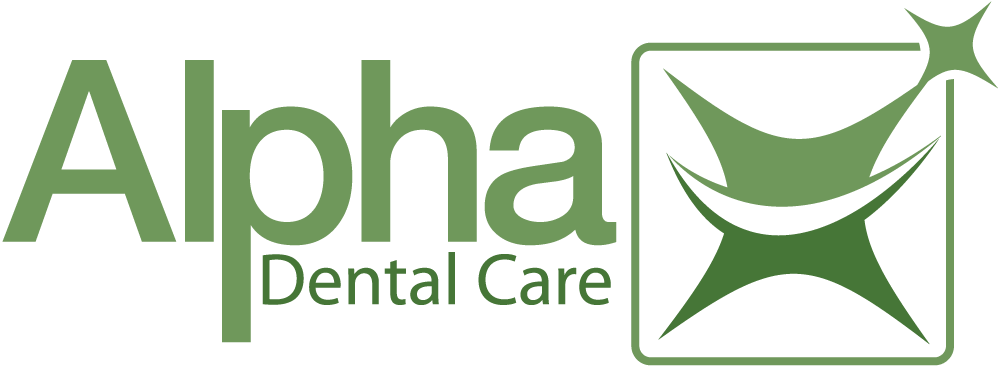Oral Appliance Therapy for Snoring and Sleep Apnea
Studies show that as many as 40 million Americans suffer from some form of Sleep Disordered Breathing (SDB). Snoring and Sleep Apnea are some common forms of SDB.
Snoring
The sound of snoring comes from tissue that vibrates as you breathe through a narrow airway. Men tend to have narrower airways then women which makes them more prone to snoring. The airway is partially obstructed during snoring. Snoring is one of the biggest indicators of Sleep Apnea.
When you are awake, your airway is completely open and you can breathe fine. But when you lay down, especially on your back and relax to fall asleep, your jaw also relaxes, causing the lower jaw to fall backward. When this happens the tissue in your mouth and throat also falls backward partially or fully closing your airway for a period of time, usually lasting a few seconds. When your airway partially or completely closes, for any period during sleep, it is considered Obstructive Sleep Apnea.
When you are awake, your airway is completely open and you can breathe fine. But when you lay down, especially on your back and relax to fall asleep, your jaw also relaxes, causing the lower jaw to fall backward. When this happens the tissue in your mouth and throat also falls backward partially or fully closing your airway for a period of time, usually lasting a few seconds. When your airway partially or completely closes, for any period during sleep, it is considered Obstructive Sleep Apnea.
Sleep Apnea
22 million American suffer from sleep apnea, a condition in which you stop breathing, for a few seconds, while you are sleeping. At this time there are three identifiable types of sleep apnea which require different types of treatment. Obstructive sleep apnea (OSA) occurs when the blockage of your airway causes you to stop breathing or decreases the volume of air you receive. The severity of your sleep apnea is determined by how many times your breathing stops or decreases in an hour.
Up to ninety percent of people with OSA have not been diagnosed and do not know that they have sleep apnea. This can be very serious, because sleep apnea can lead to many other health problems including obesity, high blood pressure, diabetes, heart disease, and even death. Drowsiness or falling asleep while driving is becoming one of the biggest causes of traffic accidents.
Up to ninety percent of people with OSA have not been diagnosed and do not know that they have sleep apnea. This can be very serious, because sleep apnea can lead to many other health problems including obesity, high blood pressure, diabetes, heart disease, and even death. Drowsiness or falling asleep while driving is becoming one of the biggest causes of traffic accidents.
Symtoms
- Loud snoring
- Choking or Gasping during Sleep
- Frequent urination during the night
- Dry Throat when you wake up
- Morning Headaches
- Feeling tired even when you have had enough sleep
- Fighting sleepiness during the day
- Not being able to concentrate
- Memory or learning problems
- Mood swings, Feeling irritable
If you have any of these symptoms and think you may have sleep apnea the first step is to talk to your doctor and have a sleep study done. A sleep study is where they monitor you during sleep to see if you have apnea and to diagnose the kind of sleep apnea you have.
Treatment
Once diagnosed with sleep apnea the next step is to decide what type of treatment would be appropriate. There are three different options for treating sleep apnea: surgery, a CPAP machine, or an oral appliance.
Surgery
Surgery can be effective when it comes to treating snoring, but is less effective when it comes to treating OSA. The most common surgery for OSA is Uvulopalatopharyngoplasty (UPPP), which removes multiple areas of tissue. Surgery has only a 50% success rate, can be painful, and has a long recovery time. The tissue also can grow back after surgery requiring additional surgery or treatment.

CPAP
CPAP stands for continuous positive airway pressure. A CPAP machine is a mask worn over your mouth and/or nose that forces air down your airway to keep it open. This option is usually used on moderate to severe sleep apnea. However, there are down sides to the CPAP machine, the biggest complaints being discomfort and difficult mobility. You usually need to sleep on your back, and it is hard to move in the middle of the night while you sleep. Other issues include air leaking and waking you up in the middle of the night, difficulty in getting up in the middle of the night to get a drink or using the restroom. Swallowing air, dry eyes, chronic sinusitis, and distended belly have also been reported. The typical rate of compliance for people treated with CPAP is between 49%-83% in ninety days. Most people will give up on using a CPAP machine rather quickly

Oral Appliance Therapy
Oral Appliance Therapy, also known as a snore guard, is used mainly by people with mild to moderate sleep apnea. A snore guard looks like a mouth guard or night guard, one half going over your top teeth and one going over your bottom teeth. The use of oral appliances has a high rate of success approaching 90%-95%. In fact most people who are not able to tolerate a CPAP machine will use a snore guard. We make many different types of snore guard in our office, the benefits which include:
- Custom fit for maximum comfort
- Durable
- Easy to adjust

Oral Appliance Therapy : Snore Guard
The oral sleep appliance works by keeping your lower jaw forward which in turn lifts your tongue and tissue at the back of the throat forward, keeping them from blocking your airway. This method is used in CPR during emergency situations to maintain an open airway. Most of the appliance we make in our office are even adjustable at home with a key provided with the snore guard. The key allows you to adjust your lower jaw to maximize comfort and function of the device. Since this appliance is adjustable it is, therefore more effective. The farther forward you are able to bring your jaw the more open your airway becomes.
Patient Testimonials for Snore guard
“After using the CPAP for a year I heard about the snore guard and it was a “life saver” for me! I couldn’t tolerate the tube, so with the snore guard I slept much better. It didn’t take any time for me to get accustomed to it. There is no comparison as to the comfort between the CPAP and snore guard!”
“After using the CPAP for a year I heard about the snore guard and it was a “life saver” for me! I couldn’t tolerate the tube, so with the snore guard I slept much better. It didn’t take any time for me to get accustomed to it. There is no comparison as to the comfort between the CPAP and snore guard!”
-Doris Rhea
The doctors at Alpha Dental Care are members of the American Academy of Dental Sleep Medicine. They are able to treat snoring and sleep apnea with oral appliance therapy. If you are diagnosed of sleep apnea after your sleep study, the next step is to make an appointment for consultation. If you decide to get an oral appliance, it only takes a few easy steps. If you can’t tolerate your CPAP machine, call us or fill out the form below for a consultation.

